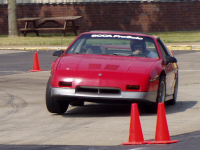- LinuxCNC
- General LinuxCNC Questions
- Suggestions for a better choice for axes at home in ClassicLadder
Suggestions for a better choice for axes at home in ClassicLadder
- rootboy
-
 Topic Author
Topic Author
- Offline
- Senior Member
-

Less
More
- Posts: 76
- Thank you received: 25
27 Oct 2020 06:48 #187379
by rootboy
Suggestions for a better choice for axes at home in ClassicLadder was created by rootboy
Hi guys,
Currently I'm using:
net home-z => classicladder.0.in-07
net home-x => classicladder.0.in-08
in my CL program to make sure that I am homed before I change tools. A couple of things are going on that makes me think that there might be a better choice for detecting that the X & Z axes are at home rather than these inputs.
1) Both home-z and home-x report that their axis is at home while running the homing sequence. Kinda odd if you ask me... This I "filtered out" using a pair of timers to inhibit the changer for 3.5 seconds during the initial homing sequence, and for 1 second for subsequent moves. It's a kludge, but it works reliably.
More importantly, I don't always get an at home signal after sending the axis to home. Which means my tool changer won't index to the tool that I want, and the program just sits there. This one is a show-stopper.
I could always just look at the current position of the axes and decide if the tool changer is in the clear, but if there is a standard way of doing this I'd rather do that.
Thanks!
John
Currently I'm using:
net home-z => classicladder.0.in-07
net home-x => classicladder.0.in-08
in my CL program to make sure that I am homed before I change tools. A couple of things are going on that makes me think that there might be a better choice for detecting that the X & Z axes are at home rather than these inputs.
1) Both home-z and home-x report that their axis is at home while running the homing sequence. Kinda odd if you ask me... This I "filtered out" using a pair of timers to inhibit the changer for 3.5 seconds during the initial homing sequence, and for 1 second for subsequent moves. It's a kludge, but it works reliably.
More importantly, I don't always get an at home signal after sending the axis to home. Which means my tool changer won't index to the tool that I want, and the program just sits there. This one is a show-stopper.
I could always just look at the current position of the axes and decide if the tool changer is in the clear, but if there is a standard way of doing this I'd rather do that.
Thanks!
John
Please Log in or Create an account to join the conversation.
- Aciera
-

- Offline
- Administrator
-

Less
More
- Posts: 4564
- Thank you received: 2031
27 Oct 2020 07:48 - 27 Oct 2020 08:10 #187385
by Aciera
Replied by Aciera on topic Suggestions for a better choice for axes at home in ClassicLadder
What about:
If you are using 2.8, that is.
joint.N.homed OUT BIT (DEBUG)
TRUE if the joint has been homedIf you are using 2.8, that is.
Last edit: 27 Oct 2020 08:10 by Aciera.
The following user(s) said Thank You: rootboy
Please Log in or Create an account to join the conversation.
- Todd Zuercher
-

- Away
- Platinum Member
-

Less
More
- Posts: 4688
- Thank you received: 1433
27 Oct 2020 13:25 - 27 Oct 2020 13:25 #187412
by Todd Zuercher
Replied by Todd Zuercher on topic Suggestions for a better choice for axes at home in ClassicLadder
How about using a
near
component to measure if the joint-pos-cmd is where you want it to be?
Last edit: 27 Oct 2020 13:25 by Todd Zuercher.
The following user(s) said Thank You: rootboy
Please Log in or Create an account to join the conversation.
- rootboy
-
 Topic Author
Topic Author
- Offline
- Senior Member
-

Less
More
- Posts: 76
- Thank you received: 25
27 Oct 2020 15:11 #187431
by rootboy
Replied by rootboy on topic Suggestions for a better choice for axes at home in ClassicLadder
Thanks guys! I've give both of them a try.
John
John
Please Log in or Create an account to join the conversation.
- rootboy
-
 Topic Author
Topic Author
- Offline
- Senior Member
-

Less
More
- Posts: 76
- Thank you received: 25
28 Oct 2020 05:05 #187507
by rootboy
Replied by rootboy on topic Suggestions for a better choice for axes at home in ClassicLadder
I ended up using both. I had made a poor choice of signals (mine) and the "joint.N.homed" signals work much better. I followed that up with using the "near" function to give myself a bit of wiggle room (.1").
Thanks again,
John
Thanks again,
John
Please Log in or Create an account to join the conversation.
- Todd Zuercher
-

- Away
- Platinum Member
-

Less
More
- Posts: 4688
- Thank you received: 1433
28 Oct 2020 14:19 #187575
by Todd Zuercher
Replied by Todd Zuercher on topic Suggestions for a better choice for axes at home in ClassicLadder
I wasn't sure how much good the joint homed pin would be for your purpose. Which is why I suggested using the near component. It has nothing to do with the joints position relative to it's origin. It only indicates that the joint has "been" homed. and stays true regardless of where it is moved after that, unless the joint becomes unhomed for some reason.
The following user(s) said Thank You: rootboy
Please Log in or Create an account to join the conversation.
- rootboy
-
 Topic Author
Topic Author
- Offline
- Senior Member
-

Less
More
- Posts: 76
- Thank you received: 25
29 Oct 2020 05:52 #187651
by rootboy
Replied by rootboy on topic Suggestions for a better choice for axes at home in ClassicLadder
The joint homed pin helps in that it tells me that the lathe is homed and as long as the lathe is near home, it's safe to change tools. So both were important to what I needed.
Today was spent in getting the lathe to go to home on its own if a tool change command was issued while the lathe was not at home.
There probably is an easier way to do this, but since a MDI command has been issued, one which I can't complete since the lathe isn't in the home position, I acknowledge the tool change command as if I had done it, removing it from the command stack. I then issue G0G53X0 and a G0G53Z0 commands to move to home, and then do the tool change.
Works very well.
Today was spent in getting the lathe to go to home on its own if a tool change command was issued while the lathe was not at home.
There probably is an easier way to do this, but since a MDI command has been issued, one which I can't complete since the lathe isn't in the home position, I acknowledge the tool change command as if I had done it, removing it from the command stack. I then issue G0G53X0 and a G0G53Z0 commands to move to home, and then do the tool change.
Works very well.
Please Log in or Create an account to join the conversation.
- Mike_Eitel
-

- Offline
- Platinum Member
-

Less
More
- Posts: 1052
- Thank you received: 183
29 Oct 2020 11:29 #187671
by Mike_Eitel
Replied by Mike_Eitel on topic Suggestions for a better choice for axes at home in ClassicLadder
Have you looked into tool changer position?
The following user(s) said Thank You: rootboy
Please Log in or Create an account to join the conversation.
- Todd Zuercher
-

- Away
- Platinum Member
-

Less
More
- Posts: 4688
- Thank you received: 1433
29 Oct 2020 13:08 #187682
by Todd Zuercher
Replied by Todd Zuercher on topic Suggestions for a better choice for axes at home in ClassicLadder
In the EMCIO section of your INI file.
linuxcnc.org/docs/html/config/ini-config.html#_emcio_section
linuxcnc.org/docs/html/config/ini-config.html#_emcio_section
The following user(s) said Thank You: rootboy
Please Log in or Create an account to join the conversation.
- rootboy
-
 Topic Author
Topic Author
- Offline
- Senior Member
-

Less
More
- Posts: 76
- Thank you received: 25
29 Oct 2020 16:29 #187699
by rootboy
Replied by rootboy on topic Suggestions for a better choice for axes at home in ClassicLadder
We (as in Thurston) have just started looking into this. I'll let him handle it unless there is something that I am going to have to program. It's more of an operational issue for machinists, I'm just the humble controls engineer...
The difference being that while Thurston makes chips, I replace them.
Here's our EMCIO section:
[EMCIO]
EMCIO = io
CYCLE_TIME = 0.100
TOOL_TABLE = tool.tbl
TOOL_CHANGE_WITH_SPINDLE_ON = 1
RANDOM_TOOLCHANGER = 0
Which does bring up a different subject, a friend of Thurston's came by yesterday evening to have Thurston do a bit of surface grinding and asked why I wasn't using G28 codes. Other than it the obvious "Because it works just fine this way" I had no good answer for him.
For what I need for the tool changer, the G53 code works just fine, and will never have to be touched again. But it would be nice to see how to use the G28 code.
I see that I have to put the lathe where I want it and issue a "G28.1" to store the position. I'll play with it on the lathe when I get there.
He also mentioned G54, but I think that's what the touchoff sets does in the tool table.
Thanks again guys!
John
The difference being that while Thurston makes chips, I replace them.
Here's our EMCIO section:
[EMCIO]
EMCIO = io
CYCLE_TIME = 0.100
TOOL_TABLE = tool.tbl
TOOL_CHANGE_WITH_SPINDLE_ON = 1
RANDOM_TOOLCHANGER = 0
Which does bring up a different subject, a friend of Thurston's came by yesterday evening to have Thurston do a bit of surface grinding and asked why I wasn't using G28 codes. Other than it the obvious "Because it works just fine this way" I had no good answer for him.
For what I need for the tool changer, the G53 code works just fine, and will never have to be touched again. But it would be nice to see how to use the G28 code.
I see that I have to put the lathe where I want it and issue a "G28.1" to store the position. I'll play with it on the lathe when I get there.
He also mentioned G54, but I think that's what the touchoff sets does in the tool table.
Thanks again guys!
John
Please Log in or Create an account to join the conversation.
- LinuxCNC
- General LinuxCNC Questions
- Suggestions for a better choice for axes at home in ClassicLadder
Time to create page: 0.101 seconds
